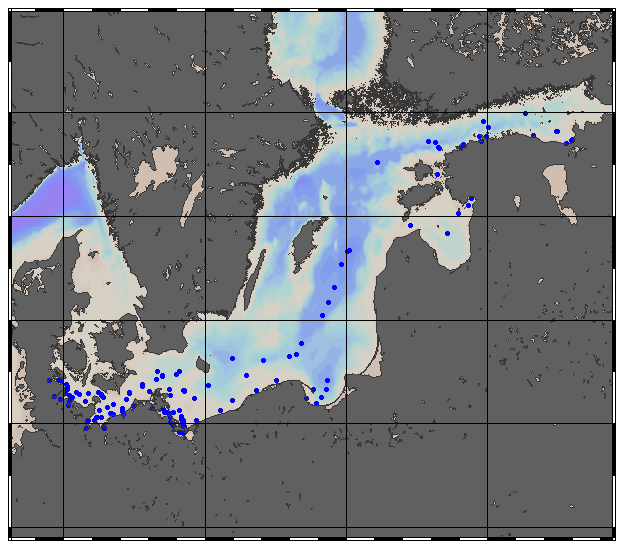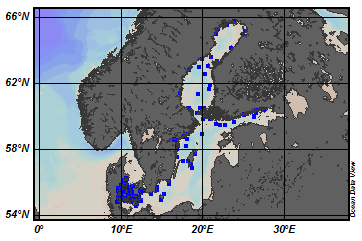Swedish Meteorological and Hydrological Institute (SMHI)
Type of resources
Available actions
Topics
INSPIRE themes
Keywords
Contact for the resource
Provided by
Years
Formats
Representation types
Update frequencies
-
RCA4-NEMO is the regional, coupled climate model at the SMHI. It consists of the RCA4 atmosphere model in a model domain covering the East Atlantic and Europe and the NEMO setup for the North Sea and Baltic Sea. RCA4-NEMO is a fully coupled atmosphere-ice-ocean model, where the different components are coupled every 3 hours using the Oasis3 coupler. The coupler does exchange the surface temperatures of open water and sea ice together with the ice fraction and ice albedo to the atmosphere model. From the atmosphere the ocean-ice model receives the momentum fluxes and pressure at the surface, the shortwave and non-solar heat fluxes and the freshwater fluxes due to the evaporation - precipitation. The freshwater fluxes due to the runoff are routed back into the ocean model using CaMa-Flood, coupled to the system with the same coupling frequency. Alternatively river discharge may be prescribed using external sources like data or hydrological models. Literature: Evaluation of the SMHI coupled atmosphere-ice-ocean model RCA4_NEMO; C. Dieterich, S. Schimanke, S. Wang, G. Väli, Y. Liu, R. Hordoir, L. Axell, A. Höglund, H.E.M Meier; SMHI-Report, RO 47, 2013, ISSN 0283-1112 BaltiX: A 3D Ocean Modelling Configuration for Baltic & North Sea Exchange Analysis; R. Hordoir, B. W. An, J. Haapala, C. Dieterich, S. Schimanke, A. Höglund and H.E.M. Meier; SMHI-Report, Oceanography 115, 2013, ISSN 0283-7714 The OASIS3 coupler: a European climate modelling community software; S. Valcke; Geoscientific Model Development Discussions, Vol. 5, 2012, 2139-2178, doi:10.5194/gmdd-5-2139-2012 A physically based description of floodplain inundation dynamics in a global river routing model; Dai Yamazaki, Shinjiro Kanae, Hyungjun Kim and Taikan Oki; Water Resource Research, Vol. 47, W04501, 2011, doi:10.1029/2010WR009726
-

EMODnet Chemistry aims to provide access to marine chemistry data sets and derived data products concerning eutrophication, ocean acidification and contaminants. The chemicals chosen reflect importance to the Marine Strategy Framework Directive (MSFD). This regional aggregated dataset contains all unrestricted EMODnet Chemistry data on contaminants; temperature, salinity and additional sampling parameters are included when available. The spatial coverage is the Baltic Sea with 3186 CDI records divided per matrices: 808 water profiles, 1556 sediment profiles and 822 biota profiles. For water, vertical profiles temporal range is from 1999-05-15 to 2018-08-27. For sediment, vertical profiles temporal range is from 1974-04-25 to 2018-08-27. For biota, vertical profiles temporal range is from 1998-09-14 to 2018-10-01. Data were aggregated and quality controlled by ‘Swedish Meteorological and Hydrological Institute (SMHI)’ from Sweden. Regional datasets concerning contaminants are automatically harvested. Parameter names in these datasets are based on P01, BODC Parameter Usage Vocabulary, which is available at: http://seadatanet.maris2.nl/bandit/browse_step.php . Each measurement value has a quality flag indicator. The resulting data collections for each Sea Basin are harmonised, and the collections are quality controlled by EMODnet Chemistry Regional Leaders using ODV Software and following a common methodology for all Sea Regions. Harmonisation means that: (1) unit conversion is carried out to express contaminant concentrations with a limited set of measurement units (according to EU directives 2013/39/UE; Comm. Dec. EU 2017/848) and (2) merging of variables described by different “local names” ,but corresponding exactly to the same concepts in BODC P01 vocabulary. Detailed documentation is available at: https://doi.org/10.6092/8b52e8d7-dc92-4305-9337-7634a5cae3f4 Explore and extract data at: https://emodnet-chemistry.webodv.awi.de/contaminants%3EBaltic The harmonised dataset can also be downloaded as ODV spreadsheet (TXT file), which is composed of metadata header followed by tab separated values. This worksheet can be imported to ODV Software for visualisation (More information can be found at: https://www.seadatanet.org/Software/ODV ). The same dataset is offered also as XLSX file in a long/vertical format, in which each P01 measurement is a record line. Additionally, there are a series of columns that split P01 terms in subcomponents (measure, substance, CAS number, matrix...).This transposed format is more adapted to worksheet applications users (e.g. LibreOffice Calc). The original datasets can be searched and downloaded from EMODnet Chemistry Download Service: https://emodnet-chemistry.maris.nl/search
-

EMODnet Chemistry aims to provide access to marine chemistry data sets and derived data products concerning eutrophication, ocean acidification and contaminants. The chemicals chosen reflect importance to the Marine Strategy Framework Directive (MSFD). This regional aggregated dataset contains all unrestricted EMODnet Chemistry data on contaminants (49 parameters), and covers the Baltic Sea with 3818 CDI records divided per matrices: 1358 biota (396 Vertical profiles and 962 Time series),906 water profiles, 2510 sediment profiles. Vertical profiles temporal range is from 1985-04-16 to 2016-09-27. Time series temporal range is from 1972-05-02 to 2017-10-30. Data were aggregated and quality controlled by ‘Swedish Meteorological and Hydrological Institute (SMHI)’ from Sweden. Regional datasets concerning contaminants are automatically harvested. Parameter names in these datasets are based on P01, BODC Parameter Usage Vocabulary, which is available at: http://seadatanet.maris2.nl/bandit/browse_step.php . Each measurement value has a quality flag indicator. The resulting data collections for each Sea Basin are harmonised, and the collections are quality controlled by EMODnet Chemistry Regional Leaders using ODV Software and following a common methodology for all Sea Regions. Harmonisation means that: (1) unit conversion is carried out to express contaminant concentrations with a limited set of measurement units (according to EU directives 2013/39/UE; Comm. Dec. EU 2017/848) and (2) merging of variables described by different “local names” ,but corresponding exactly to the same concepts in BODC P01 vocabulary. The harmonised dataset can be downloaded as ODV spreadsheet (TXT file), which is composed of metadata header followed by tab separated values. This worksheet can be imported to ODV Software for visualisation (More information can be found at: https://www.seadatanet.org/Software/ODV ). The same dataset is offered also as XLSX file in a long/vertical format, in which each P01 measurement is a record line. Additionally, there are a series of columns that split P01 terms in subcomponents (measure, substance, CAS number, matrix...).This transposed format is more adapted to worksheet applications users (e.g. LibreOffice Calc). The 49 parameter names in this metadata record are based on P02, SeaDataNet Parameter Discovery Vocabulary, which is available at: http://seadatanet.maris2.nl/v_bodc_vocab_v2/vocab_relations.asp?lib=P02 . Detailed documentation will be published soon. The original datasets can be searched and downloaded from EMODnet Chemistry Download Service: https://emodnet-chemistry.maris.nl/search
 Metadata catalogue
Metadata catalogue